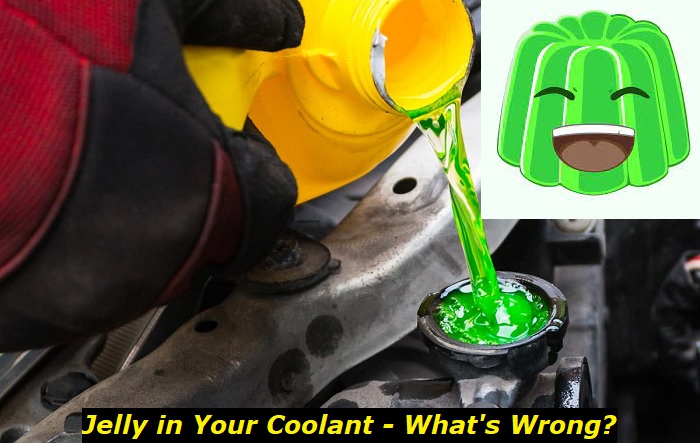As you drive your car one day, you notice your engine overheating. And although you brush it off as a one-time occurrence, it happens again and again. Soon, you notice you have to stop at gas stations more often. And sometimes, your engine even misfires. What went wrong and how can you fix it?
We prepared this article to tell you everything you need to know about the jelly-like substance in your coolant.
Cooling system problems highlights
- Level of urgency: high
- Common reasons: bad antifreeze, broken cooling equipment, leaks
- DIY diagnostics: very complicated
- DIY repair: impossible
- Price of repair: $250 - $650
- Time for repair: 3 - 8 hours
- If ignored: engine overheating and failure
Is the Jelly-like substance in coolant dangerous?
The jelly-like substance in your coolant can form in response to several issues. But no matter what caused it, this sludge can be extremely harmful to your engine. Your coolant is responsible for keeping your engine's temperature in check. If something compromises it, it won't do its job properly.
The main reason why having a jelly-like substance in your coolant is dangerous is that it leads to an overheating engine. As a result, your engine will wear down much faster than usual. If the heating system fails, your car may even stop functioning entirely. Any kind of engine damage is incredibly dangerous, and you shouldn't underestimate it.
But your issues won't end there. Once your engine breaks down, you'll have to either repair it or replace it. Unfortunately, both options are incredibly expensive, costing thousands of dollars. Fixing the coolant issue is not only much faster but also much cheaper. And fortunately, you can handle it on your own.

5 symptoms of having a jelly-like substance in your coolant
You now understand what makes the jelly-like substance in your coolant so dangerous. But you may be wondering why exactly it's so dangerous. Well, if you ignore the issue for too long, you may run into many additional problems with your vehicle.
Here are 5 common symptoms you may run into:
1) Your engine keeps overheating
One of the most impactful symptoms of a clogged coolant system is overheating. This happens when the built-up sludge blocks circulation, resulting in poor heat absorption. As a result, your engine will overheat. This leads to even more issues such as reduced longevity and even engine failure. Luckily, your vehicle should be able to detect an overheating engine - a warning light will come online on your dashboard.
2) Your engine will perform poorer
Poor performance results from an overheating engine. The excess heat will put a strain on your engine, reducing both your mileage and horsepower. This means you'll be spending a lot more time at gas stations. It may also cause secondary symptoms such as stalling and misfiring.
The extent of this symptom depends on what caused the issue in the first. Perhaps the worst example is when you have a damaged oil gasket. As the coolant and engine oil mix, the performance of both decreases. This will make the aforementioned symptoms even more pronounced.
3) Your coolant leaks
Leaky coolant is another common symptom of a clogged cooling system. As sludge builds up, it will affect the distribution of your coolant. This may increase the pressure in some parts and lead to leaks. A clogged cooling system is already dangerous - if your coolant's leaking as well, there may not be enough fluid left to cool your engine. We advise against driving a car with leaky coolant as it's incredibly dangerous.
4) Smoke coming from under the hood
One of the rarer symptoms of a clogged cooling system is white smoke coming from the engine. Sometimes, an overheating engine can produce foul white smoke. This is a sign that your vehicle is running low on coolant and is about to give out. If this happens to you, do not drive your car. Address the issue as soon as possible. Otherwise, your engine might become irreparably damaged.
5) Foul odor coming from the engine
When dirt and debris build up in the cooling system, they may produce a foul odor. You may experience this unpleasant smell during the early stages of this problem. If your car produces an unnatural odor, it's a clear sign that something is wrong with it. Make sure you check the other symptoms on this list to pinpoint what caused this issue.
3 common reasons why you have a jelly-like substance in your coolant
If you experienced any of the symptoms, it's time to check what caused them in the first place. Removing the jelly-like substance from your vehicle is relatively easy. But to do so, you need to understand the cause, not just the symptoms.
Here are 3 common reasons behind a clogged cooling system:
1) Your engine oil and coolant mix
This is arguably the most severe cause behind the sludge in your cooling system. It happens if you have damaged engine components. The most common ones are the head gasket, cylinder block, and engine block. If one of these is cracked, your engine oil and coolant may leak.
Each of the liquids is designed for a specific job. The coolant reduces heat while engine oils lower your engine's friction. Both liquids have unique properties that allow them to do their job. When they mix, the efficiency of both suffers. This leads to poor engine performance and reduced longevity.
If you use automatic transmission, the coolant may contaminate your transmission fluid as well.
2) Your cooling system becomes corroded and contaminated
Another common reason why you have jelly-like substances in your coolant is corrosion and contamination. This happens when the coolant forms deposits in the system. The accumulated debris then blocks parts of your cooling system, resulting in lower performance. Your engine will thus start overheating.
This process happens naturally over time. The best way to prevent it is to inspect the state of your coolant regularly and replace it as needed. However, it may also happen if you use the incorrect coolant for your vehicle. Make sure you always follow your manufacturer's instructions. While some coolants may be cheaper, they usually end up leading to huge expenses when your engine breaks down.
3) You use more than one additive
Your coolant contains additives such as ethylene glycol. These stabilize the fluid's freezing and boiling points. However, each product has its specific composition. If you mix two different coolants, they will often react together to form precipitation. This can accumulate in your cooling system, forming sludge in the process. Make sure you flush out the old coolant before you switch to a new product.
How to remove the jelly-like substance from your coolant - 4 simple steps
Armed with brand new coolant knowledge, it's time to end the issue once and for all. Luckily, this is one of the few car issues that you can handle on your own (at least for the most part).
Here's what you need to do to remove the jelly-like substance from your coolant:
- Flush the coolant from your system
The first step is very straightforward. Simply remove every bit of coolant from your vehicle. This will get rid of the sludge as well, ensuring the problem won't return later. Be patient when flushing the coolant as it can take a long time.
- Inspect your car for any leaks
With your coolant out of the system, it's time to check what caused the jelly-like substance to form in the first place. One of the worst culprits behind this issue is leaks. If you find any, you'll, unfortunately, have to visit a mechanic to fix them. Otherwise, the sludge will form all over again.
- Consider using a coolant system cleaner
This is an optional step. However, it may be worth your time (and money). Especially if the sludge is too persistent. These products are designed to target debris specifically, making them excellent and preventing the issue from happening again.
- Add new coolant to your car
The final step is to refill your coolant. The process is easy as long as you stick to your manufacturer's manual. Make sure you use a coolant compatible with your vehicle and you're all set.
Our final thoughts on the jelly-like substance in the coolant
A jelly-like substance in your coolant is never a good sign. It often clogs the cooling system which results in your engine overheating. An overheating engine leads to several other issues, including poor performance, bad fuel economy, and reduced lifespan.
The jelly-like substance can form because of many reasons. It can happen naturally, especially if you have an old car. However, it most commonly happens when you mix different types of products or even use the wrong coolant altogether. Make sure you always buy one compatible with your vehicle.
Another common reason is a damaged oil seal or gasket. When this happens, your coolant will mix with the engine oil. As a result, both components will fail to do their job properly.
When it comes to removing the jelly-like substance from your coolant, simply flush it from your car and refill it with a compatible one. You can also use coolant cleaning products for more thorough cleaning. Unless the system is leaking, flushing and refilling your coolant will be all you have to do to fix the issue.
About the authors
The CarAraC research team is composed of seasoned auto mechanics and automotive industry professionals, including individuals with advanced degrees and certifications in their field. Our team members boast prestigious credentials, reflecting their extensive knowledge and skills. These qualifications include: IMI: Institute of the Motor Industry, ASE-Certified Master Automobile Technicians; Coventry University, Graduate of MA in Automotive Journalism; Politecnico di Torino, Italy, MS Automotive Engineering; Ss. Cyril and Methodius University in Skopje, Mechanical University in Skopje; TOC Automotive College; DHA Suffa University, Department of Mechanical Engineering






Add comment